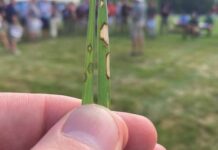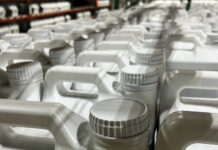Turfgrass managers are always asking me to forecast which insects will become major pests the next season. I usually quip, “It’s too complicated.” Or, I respond, “I’ll tell you why they were pests after the season is over!”
In this article, I’ll share some research-based and experience-based evidence of what is useful and what is not useful in predicting turfgrass insect outbreaks.
Many common turfgrass insects react to weather and turfgrass conditions that define each season. For example, wet soils during the typical grub egg lay period promise lots of grubs in the fall. When drought conditions arrive in June, you’ll see Kentucky bluegrass death from billbug attack. These are two obvious indicators. Outbreaks of other turf pests can be more complicated.

In southern areas, many turf managers have experienced the ravages of an armyworm outbreak shortly after sprigging or sodding bermudagrass. This usually isn’t related to the weather but rather to heavy fertilization and constant watering. These practices create conditions attractive to the moths that lay eggs over or around the struggling turf.
Conditions conducive to white grubs
The late Dr. Mike Villani, a professor at Cornell University, did a lot of work documenting the factors that drive white grub populations in large areas. Villani (tragically he died much too young from cancer), his graduate students and technicians studied how moisture affects grub movement. They put medium- to large-sized grubs into narrow soil containers and examined the containers with X-rays. Water applied to the tops of these chambers resulted in the grubs moving up (moist conditions) or down (dry conditions). Each grub species reacted differently to the experiments. Masked chafers and Japanese beetles yo-yo’ed the least, while European chafers moved many inches in a single day.
Villani and his crew also surveyed grub populations in home lawns and on golf courses. He was rather embarrassed when he reported what he felt was so obvious. First, if a lawn had a damaging grub population in one season, there was an 80 percent risk that grubs would damage the same lawn the following year. He also noted that Japanese beetle females laid their eggs in high soils during really wet seasons, but put their eggs in low areas during dry seasons. Masked chafers, which don’t fly during the day, simply emerged, mated and laid eggs in the same locations.
Also, newly established lawns or lawns less than four years old rarely had damaging grub populations. Grub populations increased to damaging levels from the fourth to fifth year and again the seventh to eighth year after the lawn’s establishment. Then grub populations dropped in importance again.
Turf entomologists speculate that turf needs to develop sufficient thatch and decomposed organic matter in the top inch of soil to support white grub feeding. It’s also possible that natural diseases, parasites and predators may be regulating grubs in older lawns.

The biggest driving factors for white grub populations are: 1.) availability of “good” organic matter, i.e., moist thatch; and 2.) soil moisture at the time of egg lay. The thatch can deliver a double whammy. The grubs can hang low and feed entirely on the thatch, including roots, stolons and crowns imbedded in it. Be aware that the upper thatch can intercept and bind grub insecticides.
Most of our turf-infesting species of white grubs fly in June and July, but southern and western species may also fly in August. Female beetles must lay their eggs during this flight period. Virtually all grub species lay dehydrated eggs that must absorb moisture from the surrounding soil in order to develop. This absorption must occur within 24 to 36 hours or the eggs will die. The tiny, newly hatched grubs are highly susceptible to desiccation. Dry soils and dry thatch are tough on their survival.
Golf course superintendents have noted that non-irrigated roughs rarely have grub issues during dry summers. Sports field managers rarely have grub problems on non-irrigated fields, and lawn care companies know that the greatest grub risks occur in lawns that are irrigated. In Ohio and surrounding states, we saw few grub problems in lawns during our dry 2013 summer. Grub issues were more common in 2014 because June and July were wetter than normal.
The take-home message is pretty simple. Damaging grub populations will most likely occur in turf that: 1.) had grub damage last year; 2.) is four to eight years old and has .5-inch of thatch or more; and 3.) is irrigated to keep it green during the summer.
The weather affects billbug damage
Damage by the bluegrass billbug is largely related to weather conditions, especially when drought occurs in June. Most Kentucky bluegrass lawns in the cool-season zones have plenty of bluegrass billbugs. Several other species can be present, as well. These pests overwinter as adults, and the females that successfully overwinter begin laying their eggs in seed-head stems in late April through May.
The larvae burrow down these stems to the crowns. If they are still small, they will tunnel into adjacent stems, but eventually they will burrow through the crown and kill the plant. During this time, the plants often react and set out new tillers in an attempt to reproduce. Unfortunately, these tillers are dependent on the “parent” plant until they can establish their own roots. If there is adequate soil moisture in late May into mid June, the new tillers establish roots, survive and the only damage noticed are some brown stems.
On the other hand, if a drought begins in early June, the new tillers often die and a single billbug can take out a patch of Kentucky bluegrass that is 4 to 6 inches in diameter. Billbugs in irrigated turf or in turf that is receiving adequate rainfall during June will rarely display damage from the bluegrass billbug. Again, the pest is always present, but the damage will only occur during June droughts.
Lawns consisting primarily of perennial ryegrass or fescue turf with endophytes are lethal to the bluegrass billbug, and damaging populations can’t get started, whether it is wet or dry in June.
The hunting billbug is a much more difficult weevil to predict. Recent research in North Carolina and in Florida has provided new information on the complex biology of this pest. In some studies, the adult weevils are causing much more damage to warm-season turf than the bluegrass weevil does to Kentucky bluegrass. Both locations have also confirmed that larval populations can overwinter, along with adults, and continue to feed on the underground portions of grasses.
My experience with this weevil in warm-season turf is that summers with prolonged periods of rain can allow for adults to continue to lay eggs over an extended period of time, and possibly encourage newly emerged adults to lay eggs in late summer. Larvae present in late summer can continue to feed on dormant turf during the cool season and cause damage that won’t be detected until the next spring when property owners notice delayed green-up.
Looking for chinch bug damage
There are big differences between the chinch bug species. There’s the hairy chinch bug in northeastern cool-season turf, the southern chinch bug in warm-season turf zones and the western chinch bug in the arid western states.
There has been a long-standing belief that hairy chinch bug populations will suffer from Beauveria, a white fungus, if the turf is kept moist during the summer. Studies in Ohio by Jennifer Andon, now my research technician, found that the opposite is true. She sampled chinch bug populations from eggs to adults over two summers in infested Kentucky bluegrass. The first summer was wetter than normal, and the chinch bugs produced an incredible second generation in July through September. The following year, the first generation was normal, but we suffered a dormancy-inducing drought in late June through August. The second generation went to near zero and the few adults that Jennifer found were often infected with Beauveria.

Lawn care specialists confirm that their greatest chinch bug issues are usually greatest on Kentucky bluegrass lawns that get regular irrigation, not on lawns that go dormant in July through August.
While looking for chinch bug populations to perform insecticide tests, my crew has developed an interesting protocol. First, we only look at sodded Kentucky bluegrass lawns usually placed on rubble that are no more than three to five years old. Second, we look for lawns that are well fertilized and/or watered. These are the risk factors that I also recommend that turf managers use.
We still don’t know enough about the southern chinch bug as populations can thrive the entire season. To confound things, St. Augustinegrass cultivars that have been previously declared as being resistant are showing chinch bug damage in some areas. Also, it appears that some populations may be resistant to several categories of insecticides. We do know that southern chinch bug does best when there is plenty of moist and fluffy thatch. Damage is often not visible in this high-maintenance turf until an irrigation head stops working or irrigation is banned due to water shortages.
Caterpillar populations
Outbreaks of fall, yellow-striped and beet armyworms in transition zones and southern zones often occur over wide areas during warm summers experiencing more than normal rainfall. In more localized areas, outbreaks appear to occur in response to high fertilizer applications and irrigation following seeding, sprigging or sodding.
Generally, populations do better during dry summers, and larvae or pupae survive the winters better when temperatures are mild. In Ohio, we saw this in 2014. Sod webworm populations were normal to slightly above normal in 2012 and 2013. These were dry summers with relatively mild winters. However the winter of 2013-14 was one of the coldest on record with several of the cold snaps occurring with minimal snow cover. Last summer was also wetter than normal from May through early September. The sod webworm population crashed.
Black cutworm populations were also very low until the end of the season. This pest cannot survive where soil temperatures drop below 25 degrees Fahrenheit. Adults from southern Florida, Texas and Mexico have to repopulate more northern areas each year. Most of the eastern half of North America has experienced extreme cold this winter, but the southern tip of Florida has escaped. It’s likely we will have another late arrival of black cutworms, and they won’t build up noticeable populations until late in the season.

Mole crickets and soil moisture
Turf managers who deal with mole crickets understand that this pest is highly regulated by soil moisture, especially in April through early June when the females are laying eggs. This highly mobile insect will cluster around streams, ponds and other low areas that have high water tables. In April, if there are frequent rainfall events or the turf is being regularly irrigated, the females will fly or crawl to the moist turf areas to lay eggs. If it is dry during this time, the females will concentrate their eggs around the water features.
Each insect group that attacks turfgrasses is largely regulated by current weather conditions, and until weather forecasters can do better at predicting weather events six to eight months out, we will be stuck with our current knowledge about how weather and soil conditions influence the populations.











![[VIDEO] Dickies®: Discover Workwear That’s Anything But Uniform](https://turfmagazine.com/wp-content/uploads/2023/06/1647663814-4b1a2a7742790a9b1e97a3b963477850192e1d6a9dfba9b07214a77bae25d6e3-d-218x150.jpg)
































![[VIDEO] Dickies®: Discover Workwear That’s Anything But Uniform](https://turfmagazine.com/wp-content/uploads/2023/06/1647663814-4b1a2a7742790a9b1e97a3b963477850192e1d6a9dfba9b07214a77bae25d6e3-d-324x160.jpg)